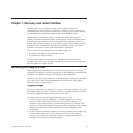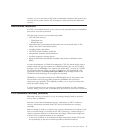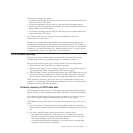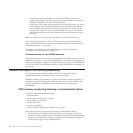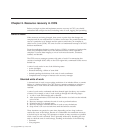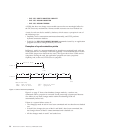2. If the failure occurs during the execution of a CICS syncpoint, where the
conversation is with another resource manager (perhaps in another CICS
region), CICS handles the resynchronization. This is described in the CICS
Intercommunication Guide.
If the link fails and is later reestablished, CICS and its partners use the SNA
set-and-test-sequence-numbers (STSN) command to find out what they were doing
(backout or commit) at the time of link failure. For more information on link
failure, see the CICS Intercommunication Guide.
When communication fails, the communication system access method either retries
the transmission or notifies CICS. If a retry is successful, CICS is not informed.
Information about the error can be recorded by the operating system. If the retries
are not successful, CICS is notified.
When CICS detects a communication failure, it gives control to one of two
programs:
v The node error program (NEP) for VTAM
®
logical units
v The terminal error program (TEP) for non-VTAM terminals
Both dummy and sample versions of these programs are provided by CICS. The
dummy versions do nothing; they allow the default actions selected by CICS to
proceed. The sample versions show how to write your own NEP or TEP to change
the default actions.
The types of processing that might be in a user-written NEP or TEP are:
v Logging additional error information. CICS provides some error information
when an error occurs.
v Retrying the transmission. This is not recommended because the access method
will already have made several attempts.
v Leaving the terminal out of service. This means that it is unavailable to the
terminal operator until the problem is fixed and the terminal is put back into
service by means of a master terminal transaction.
v Abending the task if it is still active (see “CICS recovery processing following a
transaction failure” on page 10).
v Reducing the amount of error information printed.
For more information about NEPs and TEPs, see Chapter 9, “Communication error
processing,” on page 97.
XCF/MRO partner failures
Loss of communication between CICS regions can be caused by the loss of an MVS
image in which CICS regions are running.
If the regions are communicating over XCF/MRO links, the loss of connectivity
may not be immediately apparent because XCF waits for a reply to a message it
issues.
The loss of an MVS image in a sysplex is detected by XCF in another MVS, and
XCF issues message IXC402D. If the failed MVS is running CICS regions connected
through XCF/MRO to CICS regions in another MVS, tasks running in the active
regions are initially suspended in an IRLINK WAIT state.
XCF/MRO-connected regions do not detect the loss of an MVS image and its
resident CICS regions until an operator replies to the XCF IXC402D message.
Chapter 1. Recovery and restart facilities 9





